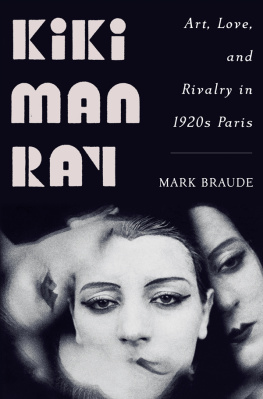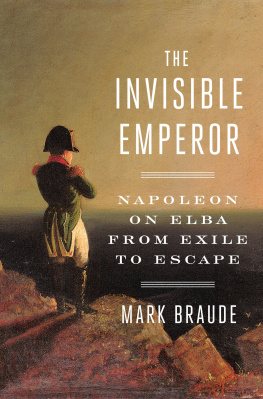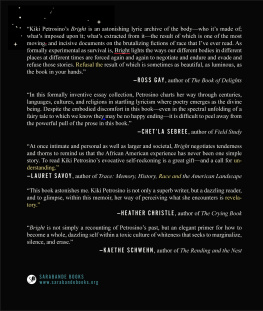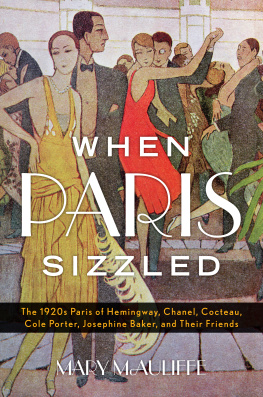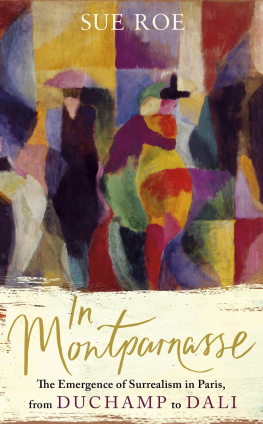
KIKI
MAN
RAY
Art, Love, and Rivalry in 1920s Paris
Mark Braude

For Laura, Lucinda, and Eloise
The Armistice offered us influenza, inflation and loss. In such a seething epoch of personal tragedy, the only thing left in which we could believe was art.
Bryher,
The Heart to Artemis (1962)

People pay money to see others believe in themselves.
Kim Gordon,
Im Really Scared When I Kill in My Dreams (1983)
CONTENTS
K IKIS NEVER SURE IF SHELL PERFORM, UNTIL SHE does. Sometimes shes not in the mood, says shes too drunk. Its different now that people come here to watch her, now that she stands in front instead of among them. They clang their cutlery and chant her name until she takes her place in the light and starts her slow-motion dance, no distance to lend her mystery, no stage to make her majestic, everyone sharing the same heat and smelling the same sweat.
She crafts her performances to suit the needs of their small society. She tells them stories about themselves they already know but want retold. Stories of orphanhood, widowhood, lovesickness, soul troubles, deceptions, gunshots, stories of ghosts, of sailors lost at sea. But also stories of pleasure, ingenuity, mischief, connection, of charming swindlers and sweet revenge, stories of good food and red wine, lucky cards and long-shot horses.
Her melodies are sweet and repetitive, music for organ grinders and dancing bears. She distorts her messages as she sends them, sways her head, runs a hand through her bobbed black hair, wrinkles her pointy nose, slumps her shoulders, fusses with her thin shawl, grinds her hips, flutters her hands. She knows when to purr, when to growl, is an expert in the well-placed sneer. She can be haughty, even cruel. But a warm bass note thrums throughout. Shes carried along by joy. She tells the dejected theyre worthy, only misunderstood. She promises shelter to the misplaced and broken. She plays to the lie that village folk are simpler and so wiser than city folk.
She never strives for the sublime. Her voice is earthbound, she knows. If a singing voice could smell, hers would be garlic hitting a pans hot butter and wine. And with her restricted range and lack of training comes the threat of disaster, though the anticipation of her fall only heightens the excitement when it fails to come. She hits her marks and stretches no further. She invites them to laugh with her and at her, so long as they keep laughing. She never blares. The citys noisy enough.
Unlike so many others performing to these kinds of small and discerning crowds across Paris, and in London and Berlin, she doesnt try to move like a machine. She moves like an animal, or many animals, impishly begging like a dog, or hunching her shoulders and raising her elbows to squawk like a bird, or stretching her mouth to bare her tigers teeth. , as one who saw her put it, wonderful like a deer.
Her words are ancient ones. Among so many would-be messengers from the future, she does no dealing in premonitions. Everyones been told the best work neither stands still nor looks backward, which is why so much of their culture comes out half-baked under the pressure for so much fresh prophecy. But Kiki is older and slower than her time and place. Her songs dont runthey lilt. She reminds her audiences, in her various guises, how in this violent, money-mad world that makes no space for its Kikis, its Kikis have always found some way to make themselves feel at home.
Her friend Robert Desnos, half mystic poet, half junkyard gleaner, has helped to craft her persona as her sometime lyricist, digging through another generations flotsam for scrap words to reinvigorate. Desnos who so loves music and sings so badly, who can recite Hugo and Baudelaire from memory and knows the plots of every Fantmas novel, who twists old jokes and bits of doggerel to speak to the problems at hand. Kiki can always find the sunken wreck beneath a songs placid surface. She takes pleasure in how certain words feel in her throat, on her tongue, talking as much as singing. The words she and Desnos string together serve as shibboleths for the initiated.
Working the crowd is another friend, more like a sister, a dance instructor calling herself Thrse Treize, a nickname coined by her sometime lover Desnos. She does acrobatic dances in front of Kiki as she sings, turning the performance into a kind of duet. And then she breaks from her dancing to go around with a hat taking collections, berating those she suspects of underpaying relative to their social station.
Kiki sings what has become her signature tune, an old folk song whose lyrics Desnos has reworked:
swears she is a virgin
Every girl from Camaret swears she is a virgin
But when theyre lying in my bed
Theyd rather hold my little head
Than a candle for the Virgin
For this she has a candlestick she rhythmically swings. Next she sings about the man who, after a thug slices open his belly with a switchblade, stuffs his guts back into his body and patches himself together with tape while waiting for the ambulance.
The affection between Kiki and her most ardent watchers springs from the recognition of shared circumstances and the understanding that surviving them can be helped by striking several poses as needed: ironic, operatic, anarchic, tender, world-weary, sinister, excessive, fearless, threatening, bored. Kiki is no diva veiled in stardust, demanding submission. She will never command an audience. All she does is let her watchers imagine that by singing about her sins, shes hearing their confessions. Telling them that they too can live how she lives if only they could access her same supposed confidence. A lie but one they enjoy hearing.
To outsiders, come to observe the bohemian tribe at its ritual, shes an entertaining creature from the lower depths, a quick thrill before returning home with reports of exotic fragrances, eerie sounds, and looming carnal violence. The tourists see only the sex and smoky eyes and miss the ceremonys sadness and solemnity. Again and again Kiki repeats her refrain to those who listen closely: that love is suffering, but suffering is beautiful so long as its done with someone else.
They stand together in that tightness, the anthropologists and the initiates, everyone watching everyone else watching Kiki. Tonight at the Jockey they must feel as if theyre standing at the white-hot center of the earth.
But how did it happen? Many of her watchers must have asked the question, thinking back, years later. How did it happen that this young woman, born poor, obscure, and illegitimate, who in her brief life barely made enough to eat, by singing old songs for tips, posing for the art of others, selling sketches to fellow drinkers spied from her barstoolhow did it happen that this young woman should be the one to capture the spirit of their age like no one else, and by doing nothing more than making a performance of herself?
T HE MAN KIKI WAS TOLD WAS HER FATHER SOLD charcoal from his buggy. When making his deliveries, he announced himself by playing on a silver trumpet. The charcoal he made by tending bonfires deep in the forest beyond the village. She remembered him inviting her into the woods and her many refusals. She never knew if he meant to harm her or if hed only wanted to embrace her, finally recognizing her as his daughter, someplace safe, away from the gaze of others.
Next page
